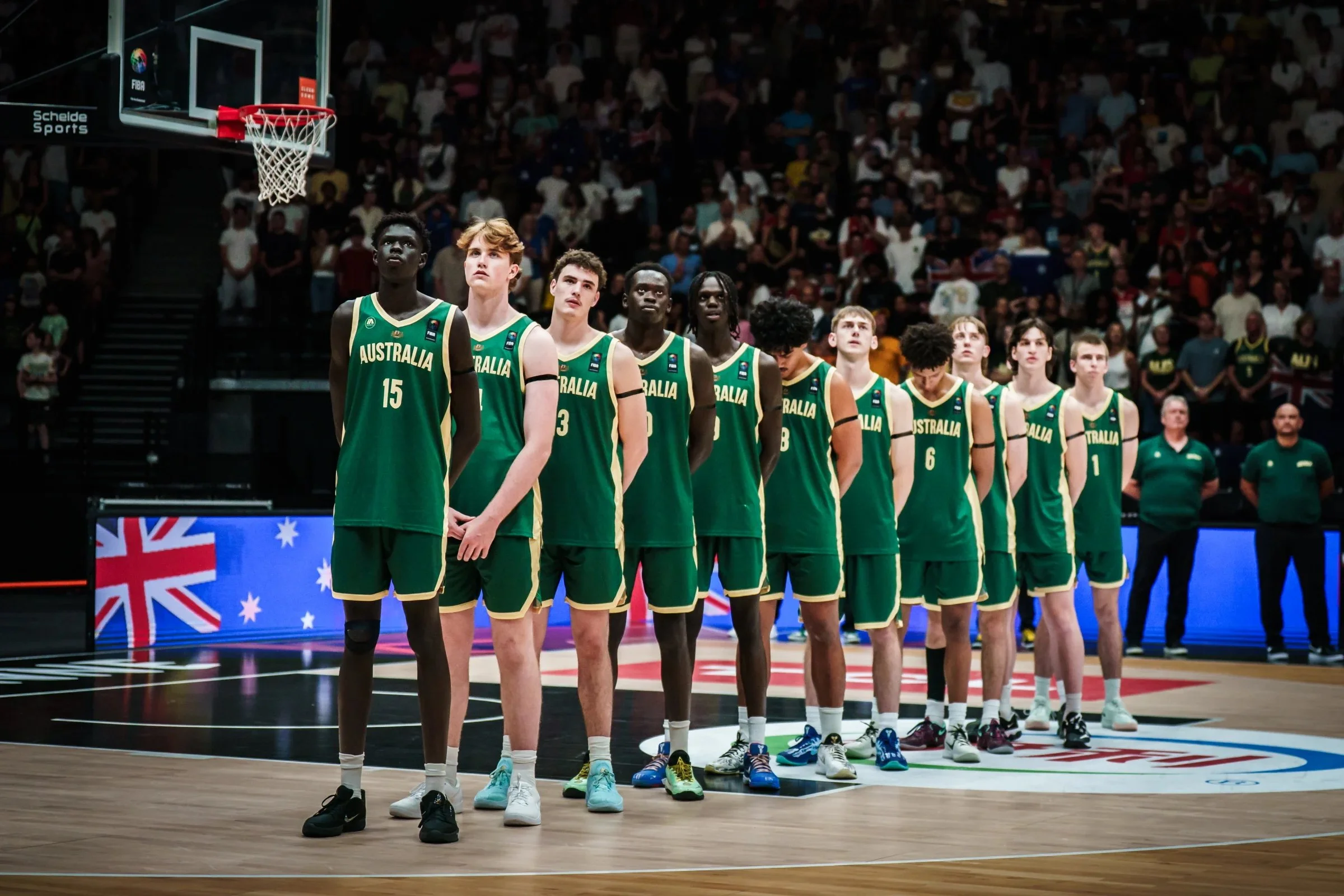Lessons from Lausanne: Six Coaching Takeaways from the FIBA U19 World Cup
Picture: FIBA
Insights and Practical Drills for Coaches & Players.
I recently had the privilege of serving as Assistant Coach for the Australian Emus at the 2025 FIBA Under-19 Basketball World Cup in Lausanne, Switzerland.
Sixteen of the world’s best junior national teams competed, each earning their place through a rigorous two-year qualification process. This marked my first experience coaching at a U19 World Cup level, and it proved to be both memorable and rewarding. Our Emus finished in 6th place – Australia’s best result at this event since 2013.
We recorded four wins against Israel (7th), France (10th), Cameroon (14th) and the Dominican Republic (15th), with our losses coming against the USA (1st), Germany (2nd) and Canada (5th).
Reflecting on the tournament, I’ve distilled six key takeaways that stood out for me – both in terms of style of play and what contributes to team success. While some insights are universal across all levels of basketball, they were especially prominent throughout this World Cup.
1. Pick & Roll Dominance
When transition opportunities weren’t available, most teams – particularly those from Europe and North America – leaned heavily on pick & roll actions. Offences often began with an early drag, step-up or spread middle ball screen and frequently finished the same way. Guard play dominated the tournament, with players constantly forced to read and react out of pick & roll situations.
For aspiring Australian juniors, developing both guard and big skills within the pick & roll context is critical to competing at the international level.
Coaching Application:
2-on-2 Progressions: Build pick & roll reads into small-sided games (SSG’s) that focus on different scenarios – e.g., drag, step-up and spread middle P&R. Start with 2-on-2, then layer in a third offence / defence to rotate or tag.
Read-React Emphasis: Train both guards and bigs in multiple decision-making progressions - reject, snake, re-screen, short roll, hit the pop, skip pass etc.
Big Development: Emphasise sprinting into screens, contact on screens, popping, slipping and short roll decision-making.
2. 1-on-1 Playmaking Is Essential
Complex, multi-action offences are becoming less common at the junior international level. If advantages weren’t gained through early movement, teams often defaulted to isolation plays, giving their best perimeter players room to create.
Many African and South American teams embraced this trend by running 5-out or 4-out, 1-in dribble-drive systems, designed to open up 1-on-1 and drive-and-kick opportunities.
To thrive in this environment, emerging Australian athletes need to develop the ability to create their own shot in 1-on-1 situations or find space off the ball to become reliable scoring options.
Just as importantly, they must also be capable of defending in isolation – staying in front and containing opponents in individual matchups.
Coaching Application:
1-on-1 Games: Practice 1-on-1 starting from realistic catches – wing, slot, top.
Score or Kick Drills: Encourage quick, purposeful decisions off the bounce with limited dribbles.
Close Outs: Focus on body control, footwork, angles and keeping players in front without fouling.
3. The Evolution of Post Play
While size still matters and dominating the paint remains important, traditional back-to-the-basket post play is fading.
Today’s 4s & 5s are increasingly hybrid players, capable of stretching the floor, handling the ball and playing out of dribble handoffs and pick & rolls. Versatile bigs who can shoot or drive, especially late in the clock, are invaluable. The best bigs in the tournament were also physical screeners, creating genuine advantages through purposeful contact.
Coaching Application:
Big Skill Workouts: Include shooting from the trail, DHO reps, attacking closeouts and pick & pop actions.
Screening Craft: Break down angles, timing & contact – reward physical, effective screens that create separation.
4v4 with Constraints: Play 4v4 half-court games where bigs must be involved in screening or DHO action before any shot is allowed.
4. Elite Point Guard Play Drives Success
Top-performing teams all had one thing in common: exceptional point guard play.
USA and Germany, who met in the gold medal game, were led by true floor generals. These players controlled tempo, made sound decisions and rarely got sped up.
Teams, in many ways, went as far as their point guards could take them.
Coaching Application:
Tempo Scenarios: Practice clock management scenarios, where guards control pace, make reads and close games – Down 5 with 45-secs left, “2-for-1”, “hold for last” etc.
Decision Box Games: Create 3-option reads out of P&R and condition guards to make quick decisions.
Leadership Reps: Rotate guards into leadership roles during scrimmages – assign them as in-game coaches with responsibilities to play-call, build communication and poise.
5. Shooting: The Skill That Separates
Another key theme throughout the tournament was the premium placed on shooting – particularly the ability to consistently knock down wide-open shots. With defensive schemes often collapsing to contain penetration or switch in pick & roll situations, teams that could space the floor and punish rotations with reliable shooting had a clear advantage. The ability to stretch the defence and convert uncontested looks wasn’t just a bonus, it was a necessity.
Becoming a confident, consistent shooter is a non-negotiable for players at this level, regardless of position.
Coaching Application:
Shooting Under Fatigue: Combine shooting with movement, sprints or defensive rotations.
Drive & Kick Games: Build habits around penetration and passing – 2 or 3-player shell drills emphasising “1 more” decision to open shooters.
High Stakes Shooting Drills: Use score-based / time-based competition, add a consequence for missed open looks.
6. Depth and Endurance Matter
With 7 games played over 9 days, endurance and roster depth were crucial. Strength and conditioning were baseline requirements, but the teams that sustained physicality and pace across rotations gained an edge.
While guard play was a major factor, depth in the frontcourt was especially important for defensive versatility and rebounding over the tournament grind.
Coaching Application:
Full Roster Reps: Design practices with SSGs where every player gets meaningful time in competitive scenarios, not just the top 5 or 6.
Rotating Lineups in Scrimmages: Create 5-minute mini-games with different lineup combinations to build chemistry and readiness across the full roster.
Ball-Conditioning: Use transition drills, O-D-O scrimmages and full-court “game pace” sequences.
Final Thoughts.
The FIBA U19 World Cup offered a powerful reminder of where the international game is headed and what it demands from players and coaches.
The speed, physicality and tactical execution on display highlighted the importance of continual development, adaptability and preparation. For aspiring junior players, it reaffirmed the need to keep pushing the boundaries in skill development, conditioning and basketball IQ to thrive on the world stage.
Coach’s Checklist for Player Development:
Build pick & roll IQ in both guards and bigs.
Prioritise 1-on-1 skill work and defensive containment.
Develop stretch bigs who can shoot, screen and pass.
Invest in point guard decision-making drills and leadership.
Create high rep shooting environments under fatigue.
Structure practice to build team depth and conditioning.
(These reflections represent my personal observations and do not necessarily reflect the official views of Basketball Australia).


